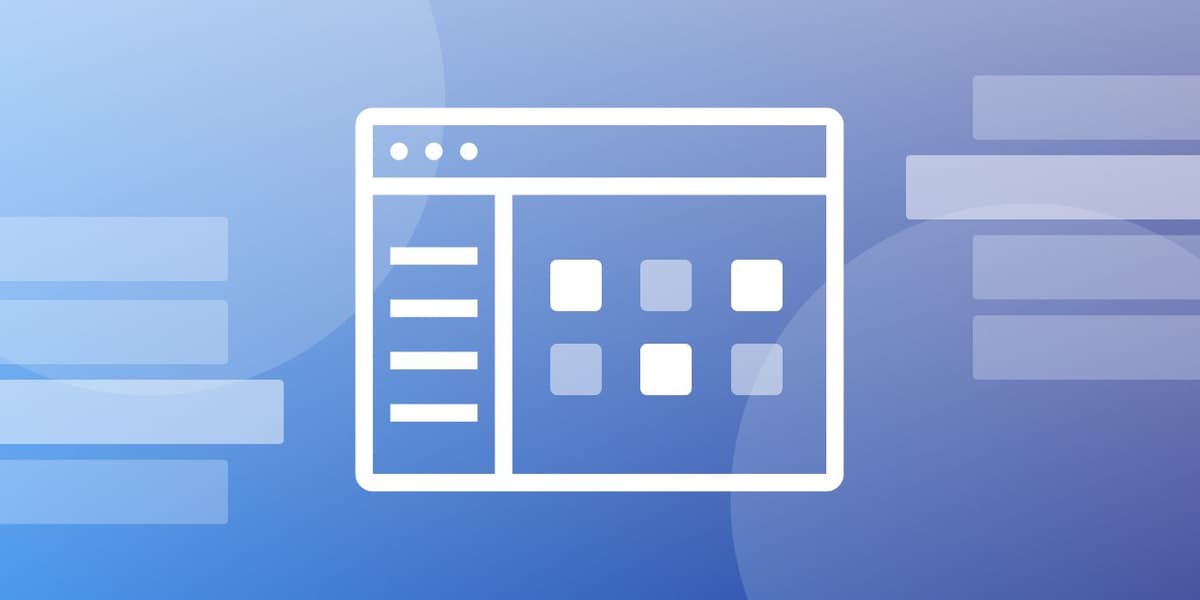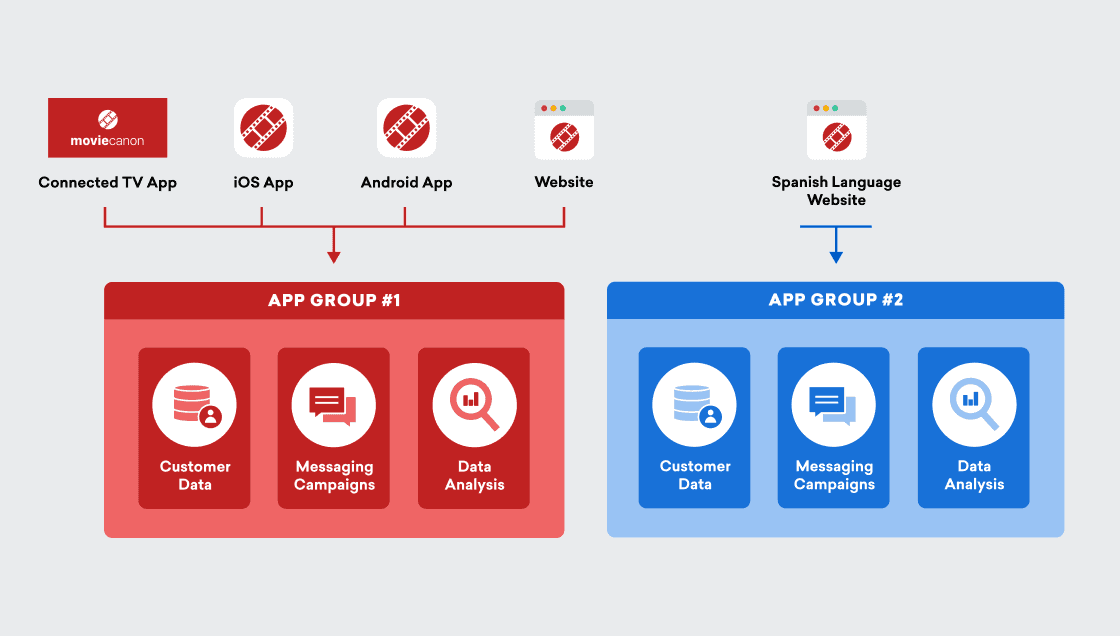Organize Your Customer Engagement Efforts with Braze App Groups
Published on November 19, 2020/Last edited on November 19, 2020/7 min read


Team Braze
While modern marketing can be fast-paced and challenging, long-term success when it comes to customer engagement requires marketing, growth, and engagement teams to plan effectively in order to meet those challenges. That means thinking through how you’re going to manage the data that you’re collecting and the campaigns you’re sending in order to ensure impactful messaging and strong business results. One of the most important things that brands need to do to make that happen is to be thoughtful about the way they set up their customer engagement platform and manage the data organization and campaigns that it makes possible.
Customer engagement today can be complex, with many companies overseeing multiple sub-brands and sporting a number of different digital properties that users can engage with—think Android and iOS apps, websites, Connected TV apps, and more. Marketers need to ensure that all the information they’re collecting is actionable and informative...but also that there’s an order and a structure to the way they’re overseeing and monitoring these different experiences. That’s where the Braze platform’s app groups feature comes in.
What Are App Groups?

At their core, app groups are a way for marketers to structure the environment within their customer engagement platform to reflect your brand’s marketing ecosystem. That ecosystem can include a variety of platforms—a website, a Connected TV presence, Android and/or iOS apps—and all of the messaging, data analysis, and audience building your team will be carrying out will exist in the app group (or groups) you create.
How Do App Groups Impact Customer Engagement?
App groups allow brands to group and/or separate different parts of their digital presence within the Braze platform, supporting coherent, consistent customer experiences. What does this look like in practice? Let’s take a fictional media brand, Politer Weekly, which operates on the following digital platforms:
- Website
- iOS app
- Android app
If Politer Weekly had the Braze SDK installed in all three platforms, they would be able to collect customer behavioral data every time one of their users engaged with one of those platforms or with a messaging campaign they’ve been sent. In this situation, Politer Weekly would likely create a single app group within the Braze platform that included all three platforms. Why? Because today’s consumers are increasingly engaging across platforms.

By creating a single app group of all three platforms, marketers at Politer Weekly could see each users’ engagement across the full scope of the company’s digital presence and then create segments or target campaigns based on that holistic view. Without an app group to organize things, a given user might be treated as multiple people—maybe they’re User_123 on your brand’s website, but User_456 on your iOS app—leading to jarring, inconsistent user experiences that can make it difficult to establish a successful relationship between that individual and your brand. By leveraging app groups, your team can ensure that you have a 360-degree view of each customer and can message them in ways that acknowledge and build off of that understanding of them as a unique individual.
However, imagine for a moment that Politer Weekly also owns a separate, Spanish language website—call it “Cortesía Semanal”—that’s based in Mexico City and has an entirely distinct user base than its English-language counterpart. If they included this website in their original app group, they’d run the risk of users being included in behavioral segments intended to target users of their other website and apps (for instance, accidentally sending a Spanish reader who has hit an engagement milestone designed for the other site a push notification in English). Given that, Politer Weekly would likely create a second app group exclusively for their Spanish-language website, in order to keep insights, segments, and campaigns distinct.
The upshot? There’s no one right way to use app groups—it’s about ensuring that the way you’ve deployed them matches the way your brand needs to view and reach different audiences.
What Are Some App Group Must-Knows?
Before you start using Braze to understand and engage your customers, you need to make some important decisions about how you’re going to leverage the platform in the future—and that includes settling on an app group strategy. To do that successfully, there are a few key things that you should keep in mind:
1. App Groups and Data
Within Braze, all user data is unique to the app group associated with its origin and no data is shared between app groups. So, for instance, if Politer Weekly did happen to have a user who engaged with both their flagship English-language website and their Spanish-language one, the data on that user’s engagement would be collected in both app groups, but neither app group would hold all the collected data on that user.
In a case like this, the smart move is to use a universal identifier for individuals in both app groups. With this approach, your team can join data from both app groups for that user—and others like them—and maintain an ongoing, holistic view of that user’s behavior and engagement with your brand, if needed.
2. App Groups and Segmentation
Just like with user data, all segments you create and campaigns you send are unique to the app group associated with them. That means that segments and campaigns can’t be automatically shared across different app groups within Braze and can only leverage data housed within the app group that they’re in. This complicates the process of sending cross-promotional campaigns highlighting other sub-brands your company may house in another app group, but it significantly reduces the chances that campaigns are sent in error to individuals, creating a broken brand experience.
3. App Group Migrations
While it’s possible to consolidate two or more app groups into one, the process requires engineering support and is generally quite manual in nature. Given that, brands are better off avoiding the need to migrate data between app groups. To reduce the risks that you’ll need to do so later on, it’s important to think through how your brand intends to interact with customers across your various different platforms before any decision is made on how many app groups you’ll need and what information will live within each one.
4. Cross-Group Communication
Ideally, most brands would set up their app group strategy to eliminate the need to move data or trigger actions between different app groups.. However, in situations where it is necessary, it’s possible to leverage webhooks to Braze API endpoints to update user profiles or trigger campaigns in other app groups. But while this approach is possible, it’s worth noting that leveraging it regularly can create complexity and additional work for the team overseeing your brand’s customer engagement efforts; given that, it’s usually a smarter move to do the work upfront to avoid leveraging this capability.
5. App Groups and Testing
One underappreciated benefit of leveraging app groups as part of your customer engagement efforts is the peace of mind they can bring when it comes to testing. Because app groups effectively separate out different parts of your marketing efforts within your customer engagement platform, it’s possible to create an app group for use as a dev environment and testing sandbox, allowing you to test messages and new tactics without ever having to worry that you might have accidentally sent out a test to your actual user base.
In addition, you can leverage Braze Teams to ensure that each member of your team only has access to the app groups relevant to them—for instance, limiting dev environment access to members of your product/engineering team and giving marketers access only to the production environment.
Final Thoughts
Nuance matters in customer engagement—it’s one of the reasons that targeted messages or personalized outreach are so impactful. But without organizational systems that allow brands to understand and handle that nuance, it’s easy for marketers to become overwhelmed by complexity. Similarly, while simplicity can be clarifying, it can also obscure important factors that could be dragging down your marketing program.
By being thoughtful about how you use app groups within Braze, it’s possible to reduce complexity, ensure clarity around your marketing efforts, and build a foundation that can support smarter, more cohesive messaging experiences going forward.
To learn more about the Braze product, visit our product page or our documentation site.
Be Absolutely Engaging.™
Sign up for regular updates from Braze.
Related Content
View the Blog
How AI Decisioning Transforms Marketing (A Complete Guide)

Team Braze

AI decisioning cheat sheet: How to crawl/walk/run with BrazeAI Decisioning Studioᵀᴹ

Team Braze

A day in the life of a data scientist on the BrazeAIᵀᴹ forward-deployed engineering team
